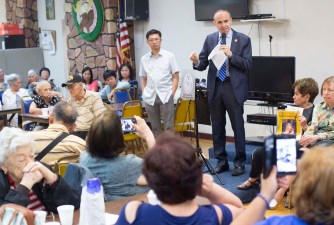DOT Promises Traffic Light at Fatal Brooklyn Intersection
But Council Member Mark Treyger says he's still "furious" at the department.

A South Brooklyn pol said he’s “furious” at the Department of Transportation’s slow and “reactionary” response toward fixing the dangerous intersection where a truck driver last month mowed down a three-year-old.
The department apparently heard the message.
Council Member Mark Treyger told Streetsblog that DOT promised him on June 3 that it would install a traffic light within three months at the corner of Benson Avenue and Bay 25th Street, where candy-truck driver Johnny Gonzalez ran over little Emur Shavkator, officials said. The department so far only has installed a painted right-turn lane on the roadway.
The child was riding a scooter as he crossed the street with his mother when Gonzales hit him on May 2, cops say. Gonzalez is facing charges of failure to yield to a pedestrian and failure to exercise due care.
But Treyger, who has sought a traffic light for years at the dangerous crossing, says that even that is not enough. (Some contend that traffic lights do not help in such circumstances, because drivers often speed up to beat the light.)

He wants further traffic-calming measures, such as “daylighting” that clears sight lines by removing parking spaces at the intersection, and better police enforcement of speeding laws.
And he faulted the DOT for letting the situation fester.
“The community knew for years that this intersection was problematic,” Treyger said, adding that “DOT needs to be more proactive. It shouldn’t just present to [community boards] after tragedy strikes.
“This death was preventable,” he added. “Emur Shavkator would be with us today if safety measures were in place.”
In the 12 months before Shavkator’s death, motorists in Treyger’s Council district — which comprises just Bath Beach, Coney Island, Sea Gate and Bensonhurst — got in 3,217 crashes, killing three pedestrians and one motorist, and injuring 75 cyclists, 203 pedestrians and 553 motorists, according to crashmapper.org.
Treyger also said DOT should not have to wait for community boards’ approval in order to take action.
“There’s a distinction between transparency and consensus,” he said. DOT should consult with communities in order to promote transparency, but should feel a “moral urgency” to move forward on pressing public-safety questions.
“We have to enter things with the mindset of saving lives and protecting public safety,” he said.
Treyger is just the latest member of the Council to lambaste DOT officials for seeking the approval of community boards on basic matters of safety and road design that are under the agency’s jurisdiction.
Earlier this year, Council Speaker Corey Johnson proposed a “master plan” for streets that would mandate safety redesigns rather than present them piecemeal to communities.
And Brooklyn Council Member Antonio Reynoso has been particularly harsh towards DOT’s consensus-building effort, scolding Commissioner Polly Trottenberg at a public hearing last year for allowing community boards to “dictate how and when bike lanes should be built based on anecdotes and personal experiences instead of expertise.”
“No more community board conversations,” Reynoso added. “Use safety to dictate exactly what you should be doing. It’s frustrating. … You always go to these community boards, and council members give you trouble. Just stop coming to us and build them where you think they are appropriate. The Police Department would never ask a community board for permission to operate in a building if they thought drugs were being sold there. No, they just do the work because they think it’s appropriate.”



